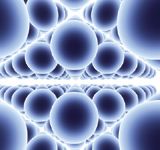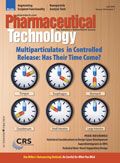Exploring the Tools in Nanoparticle Analysis
Nanotechnology is an important area of drug and biomedical research, and advancing nano-analysis is crucial for its further development.
Nanotechnology offers great promise in drug delivery and medical diagnostics, but challenges remain. The accurate and reliable characterization of nanoparticles is crucial to assess their safety, efficacy, and quality in a drug substance, drug product, or other biomedical use. But the size of the nanoparticle can make this characterization difficult. The refinement of nanoscale analytical methods is of interest for nanotechnology in general and particularly for biomedical applications.
Raman spectroscopy
Raman spectroscopy is one example of an analytical method that can be employed on a nanoscale. Raman spectroscopy measures the vibrational frequencies of various parts of a molecule. These frequencies depend on the bond strength, the mass of the bound atoms, and other factors, including intermolecular interactions and the crystalline arrangement of solids (1). While infrared (IR) spectroscopy is based on illuminating a sample with a broad range of wavelengths of IR light and measuring which are absorbed, a Raman spectrum is obtained by illuminating a sample with a single wavelength of light from a laser and collecting and analyzing the resulting scattered light. Raman spectroscopy is a nondestructive method and can be used in identifying and testing raw materials, in-process materials, polymorphs as well as for assessing content uniformity and small particulates (1, 2).

(IMAGE: PASIEKA/SPL, SCIENCE PHOTO LIBRARY, GETTY IMAGES)
In nanoparticle analysis, Raman spectroscopy is used with confocal microscopy, an optical imaging technique that increases optical resolution. "By integrating a Raman spectrometer within a confocal microscope setup, Raman imaging with a spatial resolution down to 200 nm laterally and 500 nm vertically can be achieved using visible-light excitation," explains Harald Fischer, marketing director of WITec GmbH (Ulm, Germany), a manufacturer of high-resolution optical and scanning-probe microscopy equipment.
Light from the image focal plane reaches the detector, which strongly increases image contrast and slightly increases resolution. Special filters suppress the reflected laser light while enabling the Raman scattered light to be detected with a spectrometer/charged-coupled device camera combination. With this setup, a complete Raman spectrum is acquired at each image pixel, typically taking between 760 μs and 100 ms. The individual spectra are combined to form Raman images consisting of tens of thousands of spectra. From this multispectrum file, an image is generated by integrating over a certain Raman line in all spectra or by evaluating the various peak properties such as peak width, min–max analysis, or peak position. Due to the confocal arrangement, depth profiling and 3-D imaging are also possible if the sample is transparent.
"The chemical composition of nanoparticles can thus be investigated, resulting in images showing, for example, the drug distributions, core-shell compositions, or the accumulation of polymorphs," says Fischer. "In order to image the outer and inner shape of a nanoparticle in total, the size should not be smaller than the diffraction limited resolution of the microscope, which can go down to approximately 200 nm," he says. "However, smaller particles might still show a Raman signal, which allows chemical identification or localization of the particle in a specific surrounding matrix."
Atomic force microscopy
Atomic force microscopy (AFM) is a widely used tool in nanotechnology. It can be used for imaging the surface structure and organization or the orientation of the molecules that form a nanoparticle. If the particles show specific values for adhesion or stiffness, AFM can evaluate such properties on a nanometer scale. For high-resolution surface-topography imaging along with the chemical information derived from Raman imaging, a confocal Raman microscope can be transformed into an atomic force microscope by rotating the microscope turret when using a modular instrument configuration.
"AFM is used to trace the topography of samples with extremely high resolution by recording the interaction forces between the surface and a sharp tip mounted on a cantilever," says Fischer. "The sample is scanned under the tip using a piezo-driven scan-stage, and the topography is reproduced with specialized software tools, which translate this information into images. Structures below the diffraction limit can be visualized using this imaging technique." The lateral resolution (xy) is dependent on the tip radius, which is typically in the range of 5–10 nm, whereas the height resolution (z) is typically below 1 nm.
The small size of the nanoparticle creates challenges. "Mainly the difficulties arise simply due to the fact that the nanoparticles are very small, which might make it difficult to find the right sample spot," says Fischer. "Especially for AFM investigations, it is necessary to properly fix the particles on the substrate in order to prevent movement while scanning. For combined Raman/AFM investigation, easy localization of the same sample position is of importance," he adds.
Enhanced technology
Surface-enhanced Raman spectroscopy (SERS). Raman methods are also useful in evaluating metallic nanoparticles, which can be used in nanomedicines, diagnostics, or biomedical imaging. Scientists at the National Institute of Standards and Technology (NIST) recently used surface-enhanced Raman spectroscopy (SERS) to test the properties of nanostars or star-shaped gold nanoparticles. They found that the nanostars had better optical qualities than other nanospheres commonly used for Raman enhancement, thereby making them for a range of applications, including disease diagnostics. (3).
SERS relies on metallic nanoparticles, most commonly gold and silver, to amplify signals from molecules present in only trace quantities. The NIST researchers tested the optical properties of the nanostars using two target molecules: 2-mercaptopyridine and crystal violet, which were selected because of their structural similarity to biological molecules and their large number of delocalized electrons, a characteristic that lends itself to SERS, according to NIST. The researchers found that the Raman signal of 2-mercaptopyridine was 100,000 times stronger when nanostars were present in the solution. The nanostars also enhanced the signature of crystal violet and delivered a signal about 10 times stronger than nanorods, another type of nanosphere.
Shell-isolated nanoparticle-enhanced Raman spectroscopy (SHINERS). Researchers at the Georgia Institute of Technology in Atlanta and Xiamen University in Xiamen, China, recently reported on what they have classified as shell-isolated nanoparticle-enhanced Raman spectroscopy (SHINERS), a method which they believe could be developed into a nondestructive and flexible portable characterization tool for drug and food inspections as well as for characterizing living cells through in-situ detection of cell-wall proteins (4).
Their research addressed the limitations of SERS by obtaining high quality Raman spectra of various molecules adsorbed at platinum and silver single-crystal surfaces with different facets in an electrochemical environment. In SHINERS, the Raman signal is amplified by gold nanoparticles with an ultrathin silica or alumina shell. A monolayer of these nanoparticles, or so-called "smart dust," is spread over the surface to be probed. The ultrathin coating prevents the nanoparticules from agglomerating, protects the SERS-active nanostructure from contact with the probed material, and allows the "smart dust" to conform to different contours and morphologies of a given substrate. The researchers used a three-dimensional finite-difference time-domain method to simulate the related enhancement. The results showed that SHINERS can be applied in probing surface composition, adsorption, and processes of diverse objects and morphologies. It may also be applied to general spectroscopy such as IR spectroscopy, sum frequency generation, and fluorescence.
Other methods. The NIST and the National Cancer Institute's Nanotechnology Characterization Laboratory (NCL) are engaged in ongoing research in the characterization of nanomaterial formulations for cancer treatments. Some examples of their work include isotope dilution mass spectrometric analysis of a nanoemulsion submitted by NCL for gadolinium content; the development of a method based on size-exclusion chromatography with inductively coupled plasma–mass spectrometry detection to quantitatively distinguish between free and complexed forms of gadolinium; and analysis of tissue samples for toxicological study of gold nanoparticles.
References
1. S. Webster and K.J Baldwin, Pharm. Technol. Europe, http://pharmtech.findpharma.com/pharmtech/Analytical/Raman-as-a-PAT-Tool/ArticleStandard/Article/detail/173525, accessed June 21, 2010.
2. R.L. Green and C.D Brown, Pharm. Technol. 33 (10), 72–82 (2008).
3. E. Nalbant Esenturk and A.R. Hight Walker, J. Raman Spec. 40 (1), 86–91 (2008).
4. J. Feng et al., Nature 426 (7287), 392–395 (2010).

Drug Solutions Podcast: A Closer Look at mRNA in Oncology and Vaccines
April 30th 2024In this episode fo the Drug Solutions Podcast, etherna’s vice-president of Technology and Innovation, Stefaan De Koker, discusses the merits and challenges of using mRNA as the foundation for therapeutics in oncology as well as for vaccines.